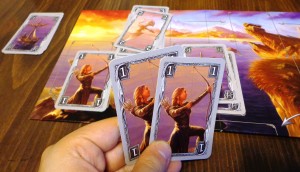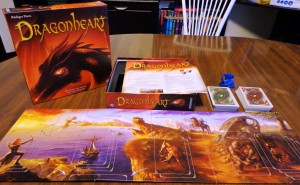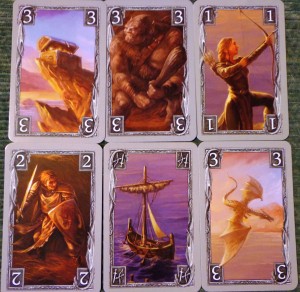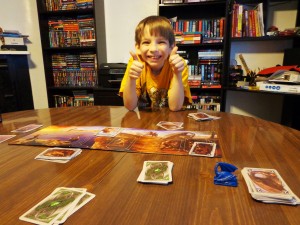I’m not sure why, but every time I think of this game’s name, I picture Mel Gibson spouting promises of freedom whilst gliding across the battlefield on a Fell Beast. It certainly would have motivated the “Sons of Scotland” to fight sooner, and I probably wouldn’t have had to see what was really under those kilts during the Battle of Stirling Bridge.
Dragonheart is a two player card game that puts two beings of equal power against each other. One player will take on the role of an evil wizard that wants to keep the Great Dragon locked away inside a jewel called the Dragonheart, and the other player will be attempting to free the dragon so that it can thwart the forces of evil. Each player will receive a deck of the same fifty cards and attempt to score the most victory points by capturing cards via a rock-paper-scissors gameplay mechanic.
Components
Board – This rectangular board contains spaces for all of the cards in the game, with arrows pointing from space to space, indicating which card “captures” what card.
Cards – There are one hundred cards, fifty of which have green backs and fifty of which has red backs. Each deck is exactly the same, so it doesn’t matter which color players decide to be. Cards contain a picture of one of the characters on the board, along with a point value.
Dragon Figure – This piece is initially placed near the petrified dragon space on the board, but switches hands as players capture more petrified dragon cards. Whoever is in possession of this figure at the end of the game scores three extra bonus points.
Setup & Gameplay
Each player gets a deck of cards and draws five cards for their starting hand. The dragon figure is placed near the petrified dragon space. A starting player is chosen randomly.
On a player’s turn, they will:
1. Play Cards:
The current player picks one card type (huntress, treasure, knight, etc) and places as many cards as they want, up to as many cards as the space allows. The huntress space has an outline of three cards…so a maximum of three cards can be put there. Spaces with an outline of one card have no limit to how many cards you can place there.
2. Collect Cards:
If a space on the board is fully occupied by a player’s card placement in step one, they “activate” that space for this turn only. They follow the arrow that the activated space points to and take all of the cards present at the target location. These captured cards are placed in a score pile to be tallied at game end.
3. Draw Cards:
The current player draws up to five cards and their turn ends.

The huntress space needs three cards to activate. I can play the two huntress cards in my hand onto the existing one, activating its space and capture the fire dragon cards nearby.
The game ends when three sets of ships have been activated and placed aside, or when a player is no longer able to draw cards from the draw deck. Points are tallied and whoever has the most, wins!
I realize that I didn’t cover all of the rules and neglected to cover what each space does, but it was necessary to keep the review moving. If you want to learn more, check out the manual here:
The Review
My son and I blew through this game in about fifteen minutes, and teaching it to him took even less time. He was confused while reading the game introduction in the manual, wondering which of us would be the evil wizard. Rather than try to explain how we’d be controlling all of the forces on the board even if some of them might be on the other side, I simply explained that this game was simply “Red vs Green.” It was much easier for him to see the game in that light.
The artwork on the cards are decent, and the card backs are pretty eye-catching. It was easy to tell which deck was which when we were separating them to put the game away. The board itself is pretty small, but does its job well.
In terms of strategy, there’s quite a bit to think about when you’re playing. The point values on your cards can make you think twice about playing it, especially if the card you are about to capture has a point value less than the card you are playing. You can play a bunch of cards at once and hope that your opponent doesn’t have the card to capture them so that you can capture them in the following turn. There’s a lot of risk in Dragonheart, though experienced players may be able to offset that by paying attention to how many card types have already been played during the game.
Vinnie (11) was a lot more aggressive than I was when playing cards, often placing three or four cards at a time when and where he could. This increased his chances of picking up a card he needed to capture those same cards in his next turn. I was able to take those cards away at times with my own cards, but his gamble did work for a while. I played a lot more conservatively, playing only the cards I needed to activate a space…though this limited to what options I had on my next turn as I wasn’t drawing a lot of new cards. I ended up winning 78-43, mainly due to a lucky pile I captured that had built up over time.
Dragonheart is a light card game, mixing a little bit of luck with a little bit of strategy. It turned out to be pretty fun and Vinnie wanted to play again afterwards, complaining that the game was too short. It would be very easy for two players to fit in three to five games in about an hour, maybe less if they knew what they were doing. I could see this game appealing to couples who just want to spend time together without having to think too much about the game they are playing. It works on family fun night as well, but obviously in a two player setting…unless your kids are willing to wait and take turns. Overall…a decent game, check it out if any of the above appeals to you!
Final Verdict: 7/10
—



